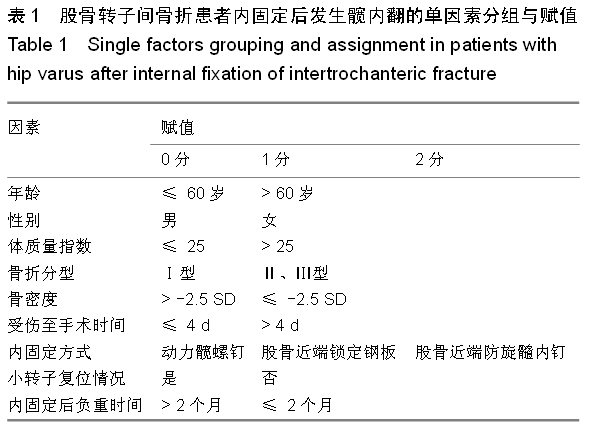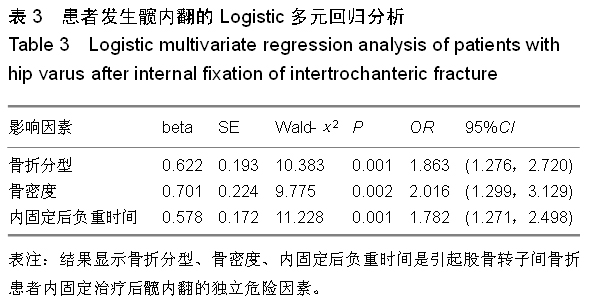| [1] 尚松,蒋赞利.股骨转子间骨折内固定失败的相关危险因素分析[J].东南大学学报:医学版,2013,32(3):324-326.
[2] 吴冰,熊发明,许宁宁.股骨转子间骨折髓内固定失败的影响因素研究[J].海南医学,2014,25(11):1597-1599.
[3] 李仁斌,林焱斌,庄研,等.股骨近端螺旋刀片抗旋髓内钉治疗股骨转子间骨折的并发症原因分析[J].中国骨与关节外科,2012,5(6): 466-470.
[4] 刘明忱,史秀梅,刘德辉.三维锁定斜孔钢板在股骨转子间骨折内固定失败髋内翻二次矫形术中的临床应用研究[J].中国骨与关节损伤杂志,2008,23(5):434-435.
[5] 章柏平,卢海峰,汤善华.Gamma钉和动力髋螺钉内固定治疗股骨转子间骨折临床疗效比较[J].临床骨科杂志,2012,15(1): 73-75.
[6] 陆骅,蒋雷生,沈雷,等.Gamma钉治疗股骨转子间骨折后髋内翻及拉力螺钉切割脱出的原因与预防[J].中华创伤骨科杂志, 2007, 9(1):10-13.
[7] Lin PC, Chang SY.Functional recovery among elderly people one year after hip fracture surgery.J Nurs Res.2004;12(1): 72-82.
[8] Zhu QL, Yan MH, Zhao LL,et al.Analysis of treatment of osteoporotic intertrochanteric fracture of femur with the locking compression plate (LCP). Zhongguo Gu Shang.2011; 24(5):378-381.
[9] 邓建龙,王剑敏,张茗慧,等.股骨近端防旋髓内钉治疗不稳定转子间骨折[J].实用骨科杂志,2012,18(1):55-57.
[10] 索南昂秀.人工股骨头置换与动力髋螺钉内固定治疗老年股骨转子间骨折的疗效比较[J].中国老年学杂志,2012,32(16): 3568-3569.
[11] 叶承锋,孙洪亮,赵乃吴.滑动加压鹅头钉治疗股骨转子间骨折术后髋内翻原因分析[J].广西医学,2003,25(1):147-148.
[12] 谢业东,江庭彪,粱科友.高龄股骨转子间骨折术后的髋内翻浅析(附38例分析) [J].广西医学,2001,23(6):1485-1486.
[13] 王鑫,张勇,张华,等.转子间截骨旋转填塞治疗股骨转子间骨折术后髋内翻[J].四川医学,2012,33(3):450-452.
[14] 王亦璁.骨与关节损伤[M]. 3版,北京:人民卫生出版社,2001: 866.
[15] 殷小军,周正明,顾家烨,等.股骨转子间骨折内固定术后发生髋内翻的相关因素分析[J].中华创伤骨科杂志,2014,16(9):809-811.
[16] 陆晴友,李增春,李国风,等.PFNA及PFNAII治疗股骨转子间骨折疗效分析[J].国际骨科学杂志,2011,32(1):54-56.
[17] 张长青.关于老年股骨转子问骨折的当代观点[J].中华骨科杂志, 2012,32(7):611.
[18] 邱志杰,杨惠林,魏立.PFNA治疗老龄不稳定股骨转子间骨折76例的临床疗效分析[J].重庆医学,2010,39(17):2270-2272.
[19] Geller JA,Saifi C, Morrison TA, et al. Tip-apex distance of intramedullary devices as a predictor of cut•out failure in the treatment of peritrochanteric elderly hip fractures.Int Onhop. 2010;34:719-722.
[20] Mereddy P,Kamath S,Ramakrishnan M,et al. The AO/ASIF proximal femoral nail antirotation (PFNA):a new design for the treatment of unstable proxinml femoral fractures. Injury. 2009: 40(4):428-432.
[21] 张业祥,鹿霞,张涛,等.DHS、PFN内固定术治疗老年股骨转子间骨折疗效对比观察[J].山东医药,2011,51(30):314-315.
[22] 郭小微,李开南.股骨转子间骨折Gamma钉内固定术后髋内翻的发生原因及预防[J].中华创伤骨科杂志,2013,15(8):728-730.
[23] Helwig P,Faust G,Hindenlang U ,et al. Finite element analysis of four different implants inserted in different positions to stabilize an idealized trochanteric femoral fracture.Injury. 2009; 40(3):801.
[24] 王金满,赵显利,靳玉普,等.髋内翻性股骨头缺血性坏死20例影像分析[J].中国医药导刊,2013,15(S):466-470.
[25] Han N,Sun Gx,Li ZC,et al.Comparison of proximal femoral nail antirotation blade and reverse less invasive stabilization system-distal femur systems in the treatment of proximal femoral Fractures. Orthopaedic Surgery.2011;3(1):7-13.
[26] Versttsd A, Ifantide SP, Chatzipaas CN, et al. systematic effects of surgical treatment of hip fractures: gliding screw-plating vs intraamedullary nailing. Injury. 2010;41(3): 279-284.
[27] 袁艾东,李文锐,李文虎.改良粗隆下截骨结合动力髋螺钉内固定治疗股骨粗隆问骨折术后髋内翻与短缩畸形[J].临床外科杂志,2013,21(7):536-538.
[28] 李伟栩,叶招明,林袱,等.截骨矫形钢板固定治疗股骨近段纤维结构不良伴髋内翻畸形[J].中华骨科杂志,2011,31(6):577-581.
[29] Domingo LJ,Cecilia D,Herrera A,et al.Trochanteric fractures treated with a proximal femoral nail.Int Orthop.2001; 25: 298-301.
[30] 宋世锋,徐孟凡,陈世强,等.动力髁钉治疗老年不稳定性转子 间骨折分析[J].中国矫形外科杂志,2008,16(16):1270-1272.
[31] 王亚梓,王蕾,张海生,等.股骨转子间粉碎骨折:小转子必须固定 吗?[J].中华创伤骨科杂志,2004,6(9):970-971,988.
[32] 周强,陆骅,俞思明,等.动力髋结合转子稳定钢板与Gamma钉内固定治疗股骨转子间骨折的比较[J].中国组织工程研究, 2014, 18(9):1441-1446.
[33] Sahin S,Erturer E,Ozturk I,et al.Radiographic and functional results of osteosynthesis using the proximal femoral nail antitotation(PFNA)in the treatment of unstable intertrochanteric femoral fractures.Acta Orthop Traumatol Turc.2010;44(2):127-134.
[34] 唐虎子,刘小卫,张立全.动力髋治疗股骨转子间骨折后髋内翻 18例分析[J].中国误诊学杂志,2009,9(1):207-208.
[35] Siwach RC,Rohilla R,Singh R,et al.Radiological and functional outcome in unstable,osteoporotic trochanteric fractures stabilized with dynamic helical hip system.Strategies Trauma Limb Reconstr.2013;8:117-122.
[36] 黄伟杰,罗涛,沈波,等.股骨近端防旋髓内钉内固定治疗股骨转子间骨折的并发症分析[J].中华创伤骨科杂志, 2010, 12(8): 790-792.
[37] Zhou F,Zhang ZS,Yang H,et al.Less invasive stabilization system (LISS) versus proximal femoral nail anti-rotation (PFNA) in treating proximal femoral fractures:a prospective
randomized study. J Orthop Trauma.2012;26(3):155-162.
[38] Namdari S,Rabinovicb R,Scolaro J,et al.Absorbable and non—absorbable cement augmentation in fixation of intertrochanterlc femur fractures:systematic review of the literature.Arch Orthop Trauma Surg.2013;133:487-494.
|

